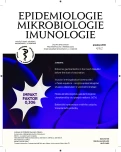Molecular biological and epidemiological characteristics of the varicella-zoster virus (VZV)
Authors:
Boštíková Vanda 1; Chlíbek Roman 1; Salavec Miloslav 2; Smetana Jan 1; Sleha Radek 1; Špliňo Miroslav 1; Boštík Pavel 3,4
Authors place of work:
Katedra epidemiologie, FVZ UO, Hradec Králové
1; Klinika nemocí kožních a pohlavních, FN a LF UK, Hradec Králové
2; Klinika infekčních nemocí, FN a LF UK, Hradec Králové
3; Centrum pokročilých studií, FVZ UO, Hradec Králové
4
Published in the journal:
Epidemiol. Mikrobiol. Imunol. 62, 2013, č. 4, s. 148-152
Summary
The genetic diversity and epidemiology of VZV results from an interplay of the geographic area, climate conditions, and population factors.
Studies of the genetic diversity of VZV can have direct implications for both the epidemiological and evolutionary analyses and identification of the genetic correlates of VZV pathogenicity or resistance to antiviral drugs.
Keywords:
epidemiology – herpes zoster – molecular genetics – varicella-zoster virus
Zdroje
1. Arvin, A. Varicella vaccine: genesis, efficacy, and attenuation. Virology, 2001, roč. 284, s. 153–158.
2. Marešová, V. et al. Varicella and its complications a 5 year long retrospective analysis of hospitalized patients. Clin. Microbiol. Infect., 2004, roč. 10, s. 669–674.
3. Boštíková, V. et al. Překvapivé výsledky molekulárně genetické analýzy klinických izolátů varicella-zoster viru (VZV). Vakcinologie, 2011, roč. 1, s. 10–12.
4. Norberg, P. Diveregence and genotyping of human alpha herpesviruses: an overview. Infect. Genet. Evol., 2010, roč. 10, s. 14–25.
5. Norberg, P. et al. Genotyping of clinical HSV1 isolates by use of restriction enzymes. J. Clin. Microbiol., 2006, roč. 44, s. 4511–4514.
6. Peters, G. A. et al. A full-genome phylogenetic analysis of VZV reveals a novel origin of replication-based genotyping scheme and evidence of recombination between major circulating clades. J. Virol., 2006, roč. 80, s. 9850–9860.
7. Loparev, V. N. et al. Improved identification and differentiation of VZV wild-type strains and an attenuated varicella vaccine strain using a VZV ORF 62-based PCR. J. Clin. Microbiol., 2000, roč. 38, s. 3156–3160.
8. Perella, D. et al. Validity of reported varicella history as a marker for varicella zoster virus immunity among unvaccinated children, adolescents, and young adults in the post-vaccine licensure era. Pediatrics, 2009, roč. 123, s. 820–828.
9. Loparev, V. N. et al. Global identification of three major genotypes of VZV: longitudinal clustering and strategies for genotyping. J. Virol., 2004, roč. 78, s. 8349–8358.
10. Davison, A. J. et al. The complete DNA sequence of varicella-zoster virus. J. Gen. Virol., 1988, roč. 67, s. 1759–1816.
11. Loparev, V. N. et al. Rapid genotyping of varicella-zoster virus vaccine and wild-type strains with fluorophore-labeled hybridization probes. J. Clin. Microbiol., 2000, roč. 38, s. 4315–4319.
12. Sahli, R. et al. A rapid phenotypic assay for aczclovir resistant VZV. Antimicrob. Agents Chemother., 2000, roč. 44, s. 873–877.
13. Sauerbrei, A. et al. Resistence testing of clinical VZV strains. Antiviral. Research., 2011, roč. 90, s. 242–247.
14. Loparev, V. N. et al. Distribution of varicella-zoster virus (VZV) wild type genotypes in northern and southern Europe: evidence for high conservation of circulating genotypes. Virology, 2009, roč. 383, s. 216–225.
15. Loparev, V. N. et al. Identification of five major and two minor genotypes of varicella-zoster virus strains: a practical two-amplicon approach used to genotype clinical isolates in Australia and New Zealand. J. Virol., 2007, roč. 81, s. 12758–12765.
16. Norberg, P. et al. Complete-genome phylogenetic approach to varicella-zoster virus evolution: genetic divergence and evidence for recombination. J. Virol., 2006, roč. 80, s. 9569–576.
17. Quinlivan, M. et al. The molecular epidemiology of VZV: evidence for geographic segregation. J. Infect. Dis., 2002, roč. 186, s. 888–894.
18. Carletti, F. et al. Rapid, differential diagnosis of orthopox- and herpesviruses based upon real-time PCR product melting temperature and restriction enzyme analysis of amplicons. Virol. Methods., 2005, roč. 129, s. 97–100.
19. Dayan, G. H. et al. Varicella seroprevalence and molecular epidemiology of VZV in Argentina, 2002. J. Clin. Microbiol., 2004, roč.42, s. 5698–5704.
20. Pahud, B. A. et al. Varicella zoster disease of the central nervous system: epidemiological, clinical, and laboratory features 10 years after the introduction of the varicella vaccine. J. Infect. Dis., 2011, roč. 20, s. 316–323.
21. Sergeev, N. et al. New mosaic subgenotype of VZV in USA. J. Virol. Methods., 2006, roč. 136, s. 8–16.
22. Koshizuka, T. et al. Characterization of varicella-zoster virus-encoded ORF0 gene-comparison of parental and vaccine strains. Virology, 2010, roč. 405, s. 280–288.
23. Sauerbrei, A. et al. Genetic profile of an Oka varicella vaccine virus variant isolated from an infant with zoster. J. Clin. Microbiol., 2004, roč. 42, s. 5604–5608.
24. Sedláček, D. Jsou komplikace planých neštovic časté? Pediatrie pro praxi, 2008, roč. 9, s. 243–247.
25. Schmid, D. S. et al. Impact of varicella vaccine on VZV dynamics. Clin. Microbiol. Rev., 2010, roč. 23, s. 202–217.
Štítky
Hygiena a epidemiologie Infekční lékařství MikrobiologieČlánek vyšel v časopise
Epidemiologie, mikrobiologie, imunologie

2013 Číslo 4
- Stillova choroba: vzácné a závažné systémové onemocnění
- Diagnostika virových hepatitid v kostce – zorientujte se (nejen) v sérologii
- Diagnostický algoritmus při podezření na syndrom periodické horečky
- Perorální antivirotika jako vysoce efektivní nástroj prevence hospitalizací kvůli COVID-19 − otázky a odpovědi pro praxi
Nejčtenější v tomto čísle
- Epidemiologie infekčních nemocí
- Bakteriální kontaminace vnitřního vzduchu transplantační jednotky
- Molekulárněbiologické a epidemiologické charakteristiky viru planých neštovic (VZV)
- Invazivní meningokokové onemocnění v České republice – analýza epidemiologické situace a doporučení k vakcinační strategii
